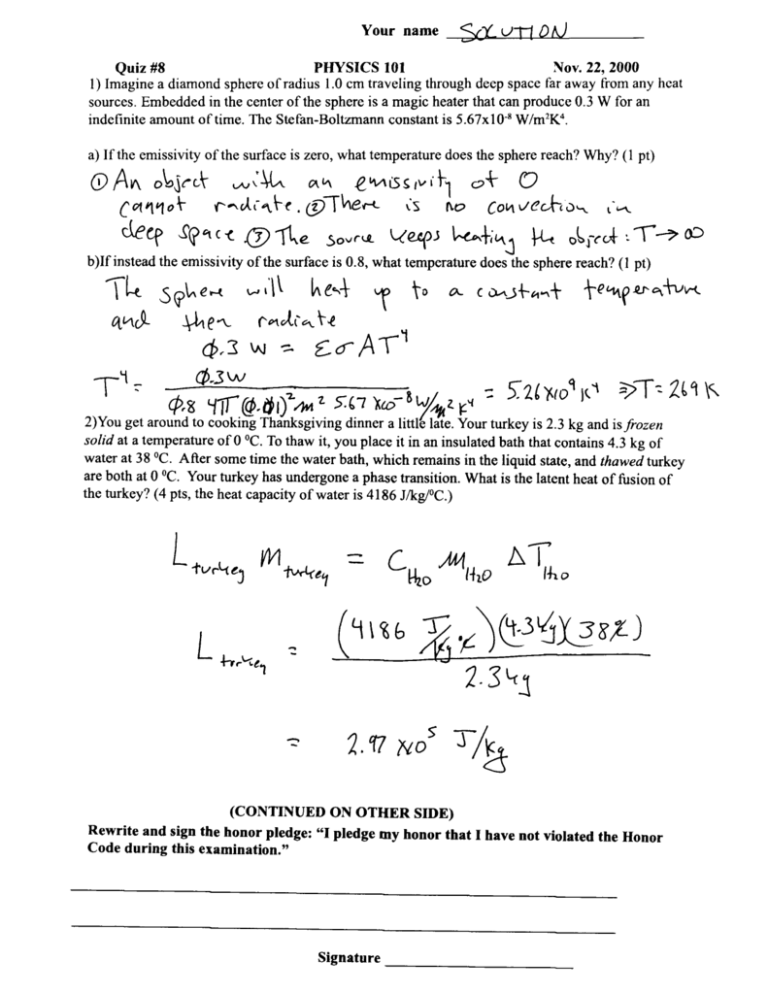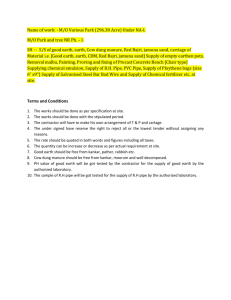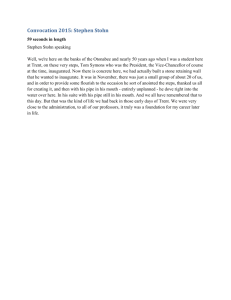Untitled
advertisement

Physics 101 Quiz #8 Solution November 20, 2002 Name 20 Minutes. Box your answers. density water copper aluminum (kg/m3 ) 1000 8890 2700 specific heat thermal coefficient of capacity conductivity thermal expansion (J/kg◦ C) (J/m s ◦ C) (1/◦ C) 4186 0.60 69 × 10−6 387 390. 17 × 10−6 900 240. 23 × 10−6 1. A 4 kg aluminum rod has a temperature of 100◦ C. It is placed into an insulated bucket containing 50 kg of water at 0◦ C. (a) [4 points] What is the equilibrium temperature of the water and aluminum? Qgained by water = Qlost by aluminum mH2 0 cH2 0 (T − 0◦ C) = mAl cAl (100◦ C − T ) (50 kg) 4186 kgJ◦ C (T − 0◦ C) = (4 kg) 900 kgJ◦ C (T − 0◦ C) 2.09 × 105 (T − 0◦ C) 2.09 × 105 T 2.13 × 105 T T = 3600 (100◦ C − T ) ◦ = 3.6 × 105 C − 3600 T ◦ = 3.6 × 105 C = 1.7◦ C (If you don’t get the answer to part a, use T = 50◦ C in part b.) (b) [2 points] The original length of the aluminum rod was 0.50 m. By how much did its length change? ∆L = αL0 ∆T = (23 × 10−6 )(0.5 m)(100.0◦ C − 1.7◦ C) = 0.0011 m = 1.1 mm Continued on the other side.... 2. In an industrial lab, a vat of liquid at 20◦ C must be heated. This is accomplished by running a hot water pipe of length 0.50 m and radius 4.0 cm (0.04 m) through the vat. The pipe is made of 2.0 mm (0.002 m) thick copper. The water flowing through the pipe has an average temperature of 60◦ C. (a) [2 points] How much heat flows through the wall of the pipe in ten seconds? The pipe is a cylinder of length L = 0.5 m and radius r = 0.04 m, so the pipe wall has area A = 2πLr = 0.126 m2 . It has thickness l = 0.002 m, so 390 msJ◦ C (0.126 m2 )(60◦ C − 20◦ C)(10 s) kA∆T t Q= = = 9.8 × 106 J l 0.002 m (b) [2 points] The water in the pipe flows at a velocity of 20.0 m/s. How much does the temperature of the water change as it flows through the pipe? (Hints: (1) The temperature change is small, so your answer to part a is valid even though T is changing; (2) What mass of water flows through the pipe in 10 seconds? How can you use this number?) (Note: this solution uses different definitions of A and ∆T than part a. Flow rate is written as Qf to distinguish it from heat, which is written as Q.) 2 The cross-sectional area of the pipe is A = πr2 = π (0.04 m) = 0.00503 m2 . 2 The volume flow rate is Qf = vA = (20 m/s)(0.00503 m ) = 0.101 m3 /s. In t = 10 s, V = Qf t = (0.101 m3 )(10 s) = 1.01 m3 of water flows through the pipe. This has mass m = ρV = (1000 kg/m3 )(1.01 m3 ) = 1010 kg. The water loses the energy that passes through the pipe wall, so Q = −9.8 × 106 J, and Q = mc∆T ⇒ ∆T = Q −9.80 × 106 J = −2.3◦ C = mc (1010 kg) 4186 kgJ◦ C Rewrite and sign the honor pledge: “I pledge my honor that I have not violated the Honor Code during this examination.” Signature Physics 101 Quiz #8 Solution November 19, 2004 Name 20 Minutes. Box your answers. Constants needed in the quiz: Radius of the earth: 6.38 · 106 m Density of snow: 200 mkg3 Density of water: 1000 mkg3 Specific heat capacity of water: cH2 O = 4186 kg·J◦ C Latent heat of fusion for water/ice: Lf = 33.5 · 104 J Stefan-Boltzmann constant: σ = 5.67 · 10−8 K4 ·m 2 ·s J kg Problem 1 Soon after the earth was formed, heat released by the decay of radioactive elements raised the average internal temperature from 300 to 3000 K which roughly is the value today. (a) [2 points] Assume that the coefficient of volume expansion is β = 3 · 10−5 K−1 , how much did the radius of the earth increase when it heated. (Hint: 3 · α = β) ∆R = = ∆R = α · R · ∆T = 1 · β · R · ∆T 3 1 1 · 3 · 10−5 · 6.38 · 106 m · 2700 K 3 K 172 km (b)[2 points] The heat of the inner parts of the earth is conducted to the surface and can be measured. In North America in a surface area of A = 1 m2 the heat flow coming from underneath is Q/t = 54 · 10−3 J/s (see figure on the right). If the surface temperature is 15◦ C and the thermal conductivity of the rocks in the upper part of the earth is k = 2.5 s·m·J◦ C , what is the temperature at a depth of d = 35 km? A d earthsurface heatflowQ/t fromthecenter oftheearth A · ∆T · t d d J 35000 m Q · = 54 · 10−3 · ∆T = = 756◦ C t k·A s 2.5 smJ◦ C · 1 m2 Q=k· =⇒ The absolut temperature at 35 km is then T = 756 ◦ C + 15◦ C ≈ 770◦ C. Continued on the other side.... (c)[2 points] If an area of 1 m2 at the earth surface emits Q/t = 54 · 10−3 J/s in radiation, what would the temperature at the earth surface be, if there would be no other energy sources? Assume that the earth is a perfect black body emitter (e = 1). Q = e · σ · T 4 · A · t, T = ! 4 Q 1 · = t σ·A " 4 54 · 10−3 e=1 J 1 · ≈ 31 K J −8 2 s 5.67 · 10 K4 ·m2 ·s · 1 m (d)[2 points] The amount of heat that reaches the earth from the sun is much larger than this. A surface area of 1 m2 receives 1400 J per second from the sun. If all the energy would be absorbed by a 0.5 m layer of snow, how long would it take to melt the snow? mass of the snow: msnow = ρsnow · V = 200 kg m3 · 0.5 m3 = 100 kg heat needed to melt the snow: Q = msnow · Lf = 100 kg · 33.5 · 104 time needed to melt the snow: Q 1400J/s = 33.5·106 J 1400 J/s J kg = 33.5 · 106 J = 24000 s = 6.6 h (e)[2 points] After the snow melted, the water of 0◦ C stays on the surface and will absorb 10.1 · 105 J during the rest of the day. What is the final temperature of the water? Q = cH2 O · mH2 O · ∆T ∆T = Q 10.1 · 105 J = = 2.4◦ C cH2 O · mH2 O 4186 kg·J◦ C · 100 kg Rewrite and sign the honor pledge: “I pledge my honor that I have not violated the Honor Code during this examination.” Signature PRINT YOUR NAME: QUIZ 8 Physics 101, Fall 2005 SOLUTIONS Problem 1: Ideal Monatomic Gas Engine One mole of an ideal, monoatomic gas is contained in a cylinder closed on the top by a movable piston, and is taken through the cycle shown on the figure (A → B → C → D → A). The temperature at point A is TA = 293 K. The volume at the point A of the cycle is VA = 0.023 m3 . 2PA B C PA A D VA 3VA a. (1 pt) Determine the total internal energy UA at point A. Box your answer. UA = 3 3 nRTA = (1 mol)(8.31 J mol−1 K−1 )(293K) = 3650 J 2 2 b. (2 pts) Determine the net work performed by the gas on the surroundings (W ) in one complete cycle (A → B → C → D → A). Box your answer. PA = (1 mol)(8.31 J mol−1 K−1 )(293K) nRTA = = 105 Pa VA 0.023 m3 WABCDA = (2PA − PA )(3VA − VA ) = 2PA VA = (2 × 105 Pa)(0.023 m3 ) = 4600 J c. (2 pts) Determine the net heat exchanged with the surroundings (Q) in one complete cycle (A → B → C → D → A). Hint: pay attention to the sign! Q is positive if heat enters the system, negative if heat exits the system. Box your answer. ∆UABCDA = QABCDA − WABCDA = 0 QABCDA = WABCDA = 4600 J QUIZ 8 Physics 101 d. (2 pts) Determine the temperatures at points B, C, and D (TB , TC , and TD respectively). Box your answers. PA V A PB V B PB V B 2PA VA = → TB = TA = TA = 2TA = 2(293 K) = 586 K TA TB PA V A PA V A In a similar way, for points C and D: TC = TA PC V C 2PA 3VA = TA = 6TA = 6(293 K) = 1758 K PA V A PA V A TD = TA PA 3VA PD V D = TA = 3TA = 3(293 K) = 879 K PA V A PA V A Problem 2: Liquid Helium Storage (3 pts) Liquid helium is stored at its boiling point temperature of 4.2 K in a spherical container with radius = 0.3 m. The container is a perfect blackbody radiator (i.e.: emissivity e = 1). The container is surrounded by a spherical shield cooled at liquid nitrogen temperature (77 K). The space between the container and the shield is under vacuum. The latent heat of vaporization of Helium is LV = 2.1 × 104 J/kg. What mass of helium boils away through the venting valve in one hour? Hint: the Stefan-Boltzmann constant is σ = 5.67 × 10−8 J s−1 m−2 K−4 ). Box your answer. 4 mLV = Q = eσ4πr2 (TN4 − THe )t m= 4 eσ4πr2 (TN4 − THe )t (1)(5.67 × 10−8 J s−1 m−2 K−4 )(4π)(0.3 m)2 [(77 K)4 − (4.2 K)4 ](3600 s) = LV 2.1 × 104 J kg−1 m = 0.39 kg




